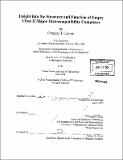Insight into the structure and function of empty class II major histocompatibility complexes
Author(s)
Carven, Gregory J. (Gregory John), 1975-
DownloadFull printable version (6.564Mb)
Other Contributors
Massachusetts Institute of Technology. Dept. of Chemistry.
Advisor
Lawrence J. Stern.
Terms of use
Metadata
Show full item recordAbstract
Class II major histocompatibility complex (MHC) proteins bind peptides and present them at the cell surface for interaction with CD4+ T cells as part of the system by which the immune system surveys the body for signs of infection. Peptide binding is known to induce conformational changes in class II MHC proteins on the basis of a variety of hydrodynamic and spectroscopic approaches, but the changes have not been clearly localized within the overall class II MHC structure. Local structural changes were mapped for HLA-DR1, a common human class II MHC variant, using a series of monoclonal antibodies which recognize the beta subunit and are specific for the empty conformation. Additional structural information was obtained using side chain-specific chemical modification and identification of modified residues by in-gel tryptic digestion and mass spectrometric peptide mapping. Together, the chemical modification studies and the mapping results illuminate aspects of the structure of the empty forms and the nature of the peptide-induced conformational change. Empty class II MHC proteins have been observed on the surface of immature dendritic cells in both humans and mice. Immature DC also secrete a protease activity that is capable of generating antigenic peptides from whole antigen. The protease activity secreted by dendritic cells is characterized and the role of empty MHC proteins in dendritic cell antigen presentation is discussed.
Description
Thesis (Ph. D.)--Massachusetts Institute of Technology, Dept. of Chemistry, June 2004. Vita. Includes bibliographical references.
Date issued
2004Department
Massachusetts Institute of Technology. Department of ChemistryPublisher
Massachusetts Institute of Technology
Keywords
Chemistry.